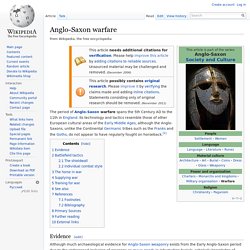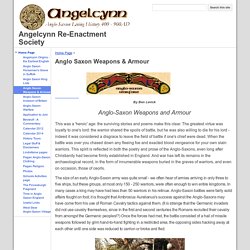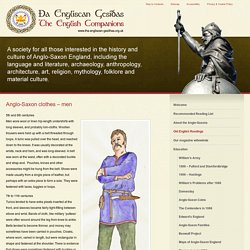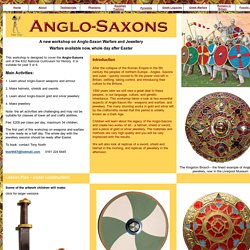

Anglo-Saxon warfare. The period of Anglo-Saxon warfare spans the 5th Century AD to the 11th in England.

Its technology and tactics resemble those of other European cultural areas of the Early Middle Ages, although the Anglo-Saxons, unlike the Continental Germanic tribes such as the Franks and the Goths, do not appear to have regularly fought on horseback.[1] Evidence[edit] Although much archaeological evidence for Anglo-Saxon weaponry exists from the Early Anglo-Saxon period due to the widespread inclusion of weapons as grave goods in inhumation burials, scholarly knowledge of warfare itself relies far more on the literary evidence, which was only being produced in the Christian context of the Late Anglo-Saxon period. These literary sources are almost all authored by Christian clergy, and thus do not deal specifically with warfare; for instance, Bede's Ecclesiastical History of the English People mentions various battles that had taken place but does not dwell on them.
Battlefield tactics[edit] See also[edit] Anglo Saxon Armour. SUTTON HOO HELMET: This helmet was found in the ship-grave at Sutton Hoo.

Can you see the two dragon's heads nose-to-nose at the front? From the little pieces it is possible to see what the whole helmet might have looked like: Reconstructed helmet. Here is what a shield probably looked like: Only the 'boss' (the middle part) and some of the metal deocorations have survived. Origin and History of the Name Ethan. Primary History - Anglo-Saxons - Anglo-Saxons at war. Anglo-Saxon warfare. Anglo-Saxon Clothes and Jewellery. An Anglo-Saxon lady wore: a loose gown fastened round her waist with a girdle;a full-length, sleeved tunic; a mantle or cloak around her shoulders;a hood over her head.

Anglo-Saxon men wore: a knee-length tunic with tight sleeves;a short cloak which was fastened on the shoulder;breeches (knee-length trousers);shoes with leather thongs which criss-crossed up their legs. Poor people wore less clothes made of rougher cloth. They often went barefoot, even in winter. The wealthy had clothes dyed with bright colours and fastened with expensive brooches. The women also wore long strings of beads made of: glass, amber or amethysts. Anglo-Saxon Clothes and Jewellery. Primary History - Anglo-Saxons - Anglo-Saxons at war. Origin and History of the Name Ethan. Anglo-Saxon warfare. Museum: Anglo-Saxon Discovery - Swords. Learning.southdowns.gov.uk/__data/assets/pdf_file/0008/442781/MTP-US-Anglo-Saxons.pdf. Anglo-Saxon warfare. Anglo Saxon Weapons & Armour - Angelcynn Re-Enactment Society.
The principle weapon of the Anglo-Saxons was the spear.

Spearheads came in many styles (Swanton classified 21 different forms), but were usually leaf- or 'kite-' shaped and had a socket for attachment to the shaft. It was usually diamond-shaped or lentoid in cross section, while the socket which continued from the narrow neck of the spearhead was split on one side and usually had an iron rivet to attach it to the shaft, which was usually of ash. Spearheads vary considerably in length from a few inches to two feet or more, and the basic forms change very little throughout the whole Anglo-Saxon period.
The overall length of the spear was around 6'6" - 8' (2.00 - 2.50m), and the butt of the spear was often capped with a metal ferrule. Spears were used both for hand to hand combat and as javelins. Spears are found in around 86% of the Anglo-Saxon burials that contain weapons. Swanton's Classification for Early Anglo-Saxon Spearheads Suppose a Frank throws his angon in an engagement. Swords. Primary History - Anglo-Saxons. Anglo-Saxon warfare. Who were the Anglo-Saxons? Behind the Name: Meaning of Names, Baby Name Meanings. Origin and History of the Name Ethan. Museum: Anglo-Saxon Discovery - Swords. Primary History - Anglo-Saxons - Anglo-Saxons at war. Primary History - Anglo-Saxons - Anglo-Saxons at war. Anglo-Saxon warfare. Anglo Saxon life - Food and Drink. The Anglo-Saxons loved eating and drinking and would often have feasts in the Hall.

The food was cooked over the fire in the middle of the house; meat was roasted and eaten with bread. They drank ale and mead - a kind of beer made sweet with honey - from great goblets and drinking horns. After the feast a minstrel would play a harp and sing songs of battles and heroes. Anglo-Saxons ate what they grew. They grew cereals - Wheat and rye for bread, barley for brewing and oats for animal food and porridge. Exotic foods such as potatoes, tomatoes, bananas, pineapples - fruits and vegetables of the New World, were unknown to the Anglo-Saxons. Drink Barley was used to make weak beer, which was drunk instead of water. Most Anglo-Saxons were vegetarians because they could not get meat very often.
Animals Pigs were important for food because they produce large litters, which would quickly mature and be ready for slaughter. Anglo-Saxon clothes - men. 5th and 6th centuries Men wore wool or linen hip-length undershirts with long sleeves, and probably loin-cloths.

Woollen trousers were held up with a belt threaded through loops. A tunic was pulled over the head, and reached down to the knees. It was usually decorated at the wrists, neck and hem, and was long-sleeved. A belt was worn at the waist, often with a decorated buckle and strap-end. 7th to 11th centuries Tunics tended to have extra pleats inserted at the front, and sleeves became fairly tight-fitting between elbow and wrist. There was undoubtedly much variation according to region, period and status. Most clothes were made at home, and would almost certainly have undergone many repairs, or have been handed down, before being eventually cut up for rags or thrown away. Underclothes were not usually dyed, but left in their natural colour, or perhaps sun-bleached.
A workshop on the Anglo-Saxons for year 5 and 6. This workshop is designed to cover the Anglo-Saxons unit of the KS2 National Curriculum for History.

It is suitable for year 5 or 6. Main Activities: 1. Learn about Anglo-Saxon weapons and armour 2. 3. 4. Note: the art activities are challenging and may not be suitable for classes of lower art and crafts abilities. Fee: £209 per class per day, maximum 34 children. Anglo Saxon Armour. Origin and History of the Name Shaun. Origin and History of the Name William.